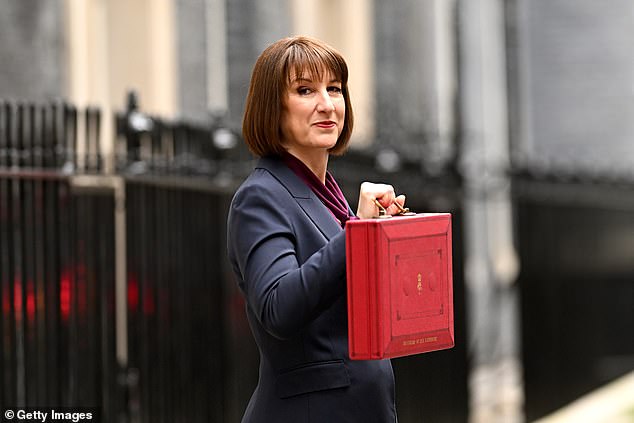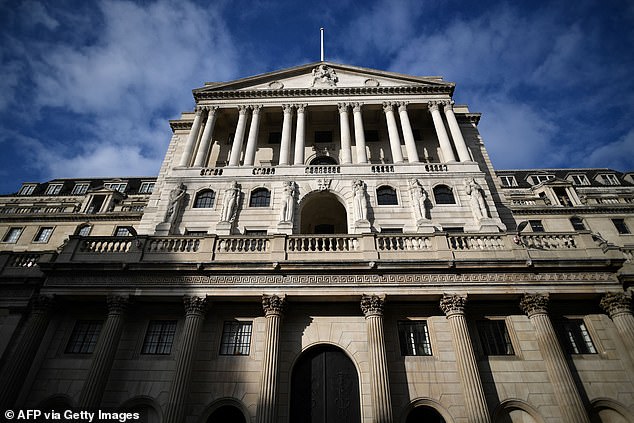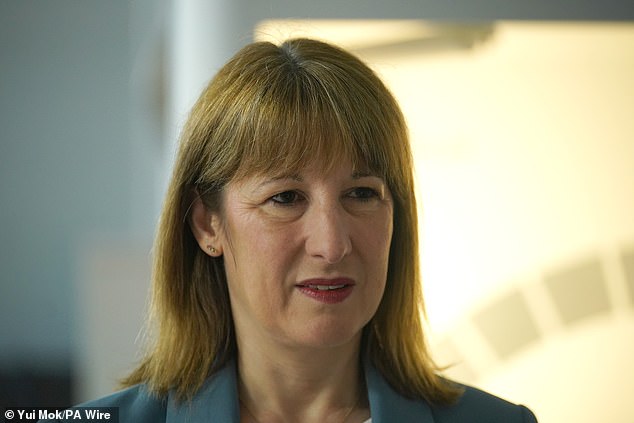By HARRIET LINE, DEPUTY POLITICAL EDITOR
Published: | Updated:
Rachel Reeves will have to increase taxes substantially this autumn to fill a £50billion black hole, economists warned last night.
In a dire warning, the National Institute of Economic and Social Research said the Chancellor would have to find the equivalent of adding 5p to income tax to keep afloat by the end of the decade and meet her fiscal rules.
Research by the respected think-tank found that the ‘wafer thin’ headroom of £9.9billion Ms Reeves left herself last year has been wiped out, and there is now a budget deficit of £41.2billion.
To fill the hole and maintain the buffer, she will have to find £51billion annually in higher taxes or lower spending by 2029/30.
Despite announcing tax rises worth £40billion in last year’s Budget, Ms Reeves has repeatedly refused to rule out a fresh raid this autumn. Labour‘s lack of an economic plan on entering government was also criticised.
Shadow Chancellor Sir Mel Stride said: ‘Experts are warning Labour’s economic mismanagement has blown a black hole in the nation’s finances which will have to be filled with more tax rises – despite Rachel Reeves saying she wouldn’t be back for more taxes.
‘Labour will always reach for the tax-rise lever because they don’t understand the economy. Businesses are closing, unemployment is up, inflation has doubled and the economy is shrinking. And Labour are refusing to rule out more damaging tax rises on investment.’
Professor Stephen Millard, deputy director of the National Institute of Economic and Social Research (NIESR), said: ‘When Labour were elected we had known for a good year or two that Labour were going to be elected, so the really disappointing thing from my point of view was that when they came in, there didn’t seem to be a plan on the table.


‘A lot of the problems the Chancellor is facing could have been almost headed off… if they had come with a clear plan. If she is going to raise £50billion, that requires large increases in taxes. Fiddling at the edges is not going to do the job.’
Labour MPs and unions have urged Ms Reeves to impose a wealth tax to balance the books. Freezing income tax bands for longer could also be on the cards.
But neither measure would bring in revenue in the region of £50billion – and she is constrained by Labour’s manifesto promise not to raise National Insurance, income tax or VAT on ‘working people’.
Speaking ahead of the publication of NIESR’s economic outlook today, Professor Millard said:
‘We think the current budget deficit in 2029/30 will be around about £41.2billion – that’s 1.17 per cent of GDP.
‘It also means that if the Chancellor wishes to maintain a buffer of £9.9billion then she will have to find £51billion either in higher taxes or in lower spending or both annually by 2029/30.’
He suggested Ms Reeves should build a bigger buffer, arguing that £9.9billion is ‘wafer thin’ and that any ‘slight change’ in fiscal circumstances would wipe it away.
But building a bigger buffer would require ‘a moderate but sustained increase’ in taxes.
Professor Millard said he expected the Chancellor to extend a freeze on income tax thresholds beyond 2028, bringing in around £8.2billion.
He said filling the £50billion black hole would be a huge undertaking, adding: ‘We’re looking at something like a five percentage point increase in both the basic rate and the higher rate of income tax.’


Professor Millard said he was not advocating such a tax rise, but was ‘trying to illustrate these are the really hard decisions the Chancellor will need to make’.
He warned that the most vulnerable in society must be protected, and public investment should be ringfenced.
NIESR calculated that the Government’s failure to pass planned welfare reforms would mean additional spending of £13.7billion, and the continuation of the winter fuel allowance will add £1.5billion.
Furthermore, the think-tank said weaker growth in output and employment – compared with the Office for Budget Responsibility (OBR) forecast – accounted for a difference of £22.2billion in 2028/29.
It also said there was a £14.3billion difference between the OBR’s March forecast for total expenditure and NIESR’s forecast.
Together, the difference between the OBR’s March forecast and NIESR’s analysis is £51billion – including the £9.9billion surplus for 2028/29 the Chancellor had in March.
The Chancellor set herself two fiscal rules – the ‘stability rule’, which ensures day-to-day spending is matched by tax revenues so the Government only borrows to invest, and the ‘investment rule’, which requires the Government to reduce net financial debt as a share of the economy.
The think-tank said the shortfall in her ‘stability rule’ in 2029/30 means she faces an ‘impossible trilemma’ of trying to meet her fiscal rules, keep spending commitments and follow a manifesto pledge to not raise taxes.
Elsewhere in the report, NIESR boosted its economic outlook for the UK, with growth of 1.3 per cent now pencilled in for 2025, up from 1.2 per cent forecast in May.
But it cut its prediction for next year to 1.2 per cent, down from the 1.5 per cent previously expected.
The think-tank also expects CPI inflation to remain well above the Bank of England’s target at around 3.5 per cent this year, and 3 per cent in the second quarter of 2026, mainly because of persistently high wage inflation, and the inflationary effects measures announced in last year’s autumn Budget.
In better news for mortgage holders, NIESR expects the Bank to cut interest rates twice more this year, giving a rate of 3.5 per cent at the beginning of 2026.
The first of the 0.25 per cent cuts could come tomorrow, when the Bank of England publishes its latest monetary policy report.
A Treasury spokesman said: ‘The best way to strengthen public finances is by growing the economy – which is our focus. Thanks to our planning reforms, the OBR has said that the economy is expected to grow by the end of the decade.’








